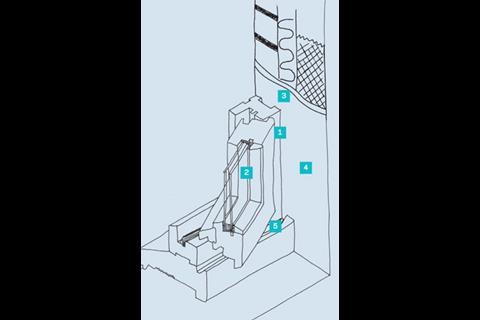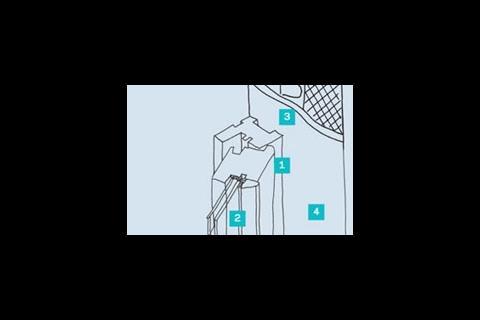Peter Mayer of Building LifePlans analyses the different ways windows can fail and how to prevent them doing so. For a full guide to suppliers, log on to www.building.co.uk/specifier
With their complex combination of moving parts and materials, there is ample potential for defects and failures with windows. These may result from more than one cause – for example, water penetration can result from the combined effects of frame distortion, inadequate weather stripping and a loose window latch.
Fortunately, the failure of windows is rarely catastrophic. Here are some of the more common problems.
1 - Ironmongery and fixings
Complex opening and closing devices are prone to damage by heavy-handed use. Ironmongery may corrode at an unacceptable rate in areas of high pollution or near the ocean. Fixings can also be damaged – for example, inadequate corrosion protection can result in them snapping. If their length or diameter is too small, fixings may come loose.
If ironmongery and fixings fail, replacing the whole window may sometimes be the only solution. To avoid having to do this, the finish of these features should be suited to the expected use and corrosivity levels. The Guild of Architectural Ironmongers and the Builders Hardware Manufacturers Association has published guidance on this. Relevant standards include:
• Operational performance of hardware and window: BS 6375-2 and BS EN 12046-1
• Mechanical durability of windows: BS EN 12400
• Corrosion resistance of hardware: BS EN 1670.
2 - Glazing failures
The most common defect that appears in windows is misting between panes of glass. Double or triple-glazed insulating glass units (IGUs) typically fail because of manufacturing faults or poor installation, which allows moisture to come into contact with the edge of units. The problem’s severity depends on the degree of water penetration and the temperature.
Fully-bedded IGUs in timber window frames mist up most commonly. Invariably this is because of poor glazing practice: lack of setting, location and blocks, and use of inappropriate sealants.
BS 8000-7 and the Glass and Glazing Federation provide guidance on glazing. IGUs to BS EN 1279 in a vented and drained glazing system are less prone to failure.
3 - Moisture penetration around the window perimeter
Damp patches on the internal wall around the window suggest moisture is finding a route into the building between the window frame and wall opening.
Most modern external walls include a cavity to prevent moisture penetrating to the inner wall, but window installations bridge that distance. To maintain the integrity of the cavity, three-dimensional junctions and components including cavity closers and trays, damp-proof courses and sealant joints, should be considered. Sealant joints minimise the risk of water penetration between the window frame and wall. These should be designed to accommodate expected frame movements and with the correct depth-to-width ratios. Primer, filler, back-up and bond break should be applied as required.
BS 5628 provides 3D illustrations of how to ensure the continuity of damp proof measures around windows set in external masonry cavity walls. Similar measures should be taken for other cavity wall constructions. BS 8000-13, BS 6213 and Ciria Report 178 on sealant joints in the external envelope of buildings, give detailed guidance on design, specification and installation. Sealants should be to BS EN ISO 11600.
4 - Surface mould
Surface mould on the internal wall is indicative of a thermal bridge. This may be owing to poor installation of thermal insulation with gaps or mortar interruptions or a design issue resulting in a linear thermal bridge.
BRE Information Paper 1/06 gives guidance on assessing the effects of thermal bridging. Hygrothermal simulation software to BS EN ISO 10211 allows this to be modelled in 2D and 3D, and appraise remedial options.
5 - Defects associated with window framing materials
Typical defects include:
• Timber: distortion, owing to moisture content or paint build-up, resulting in water leakage; decay, owing to inadequate preservative treatment
• Plastics: discolouration, embrittlement, increased risk of damage and distortion
• Steel: corrosion, where galvanizing has been damaged
• Aluminium: discolouration and opening up of corner joints.
Postscript
For durability information contact: peter.mayer@blpinsurance.com
Specifier 11 April 2008
- 1
- 2
- 3
- 4
- 5
- 6
- 7
- 8
- 9
- 10
- 11
- 12
- 13
 Currently reading
Currently readingWindow pains: Different ways windows can fail



































No comments yet